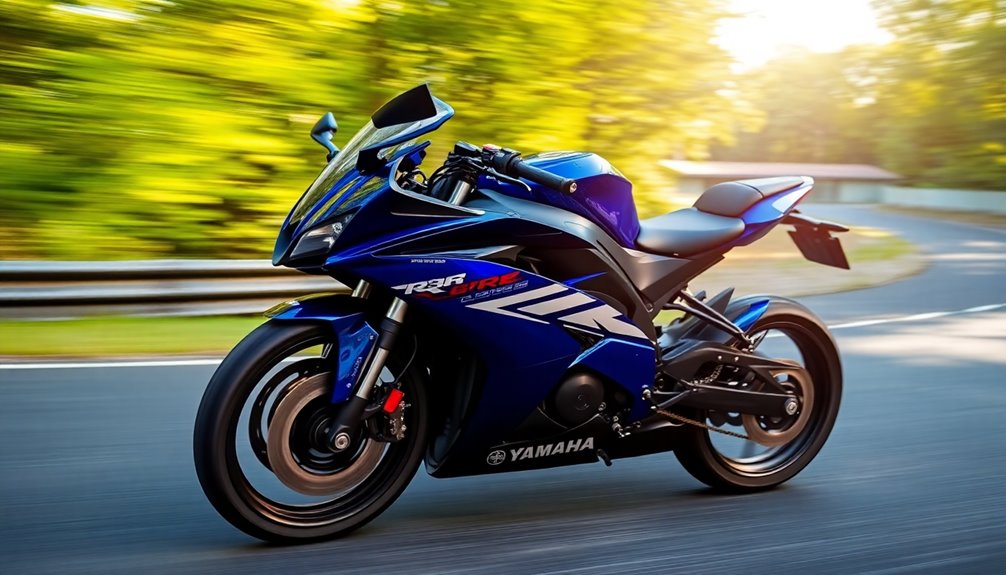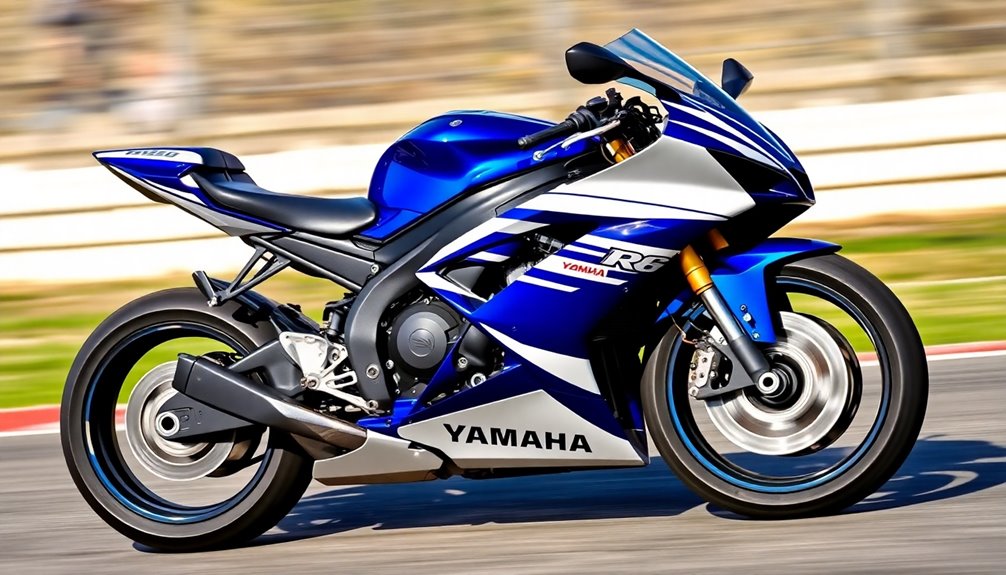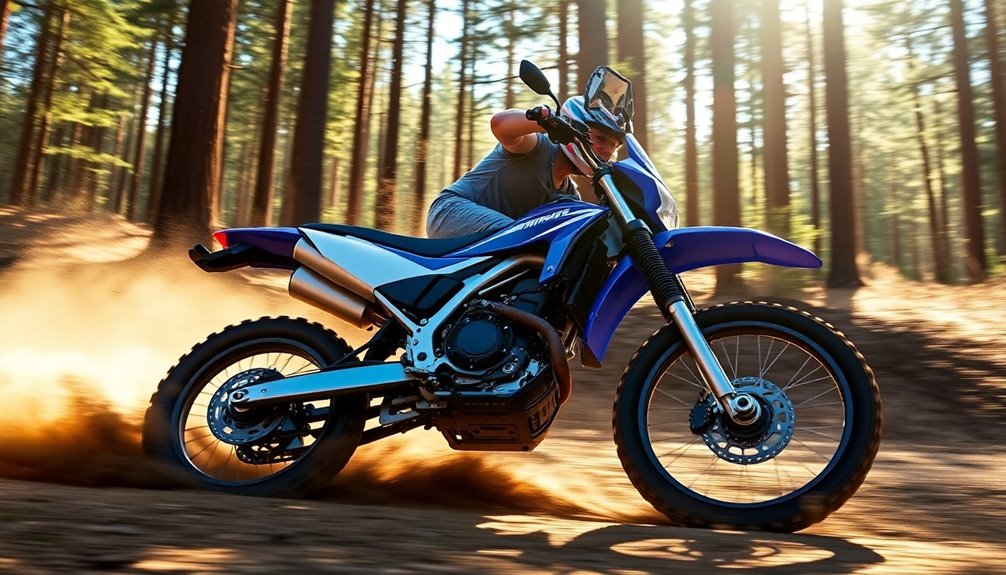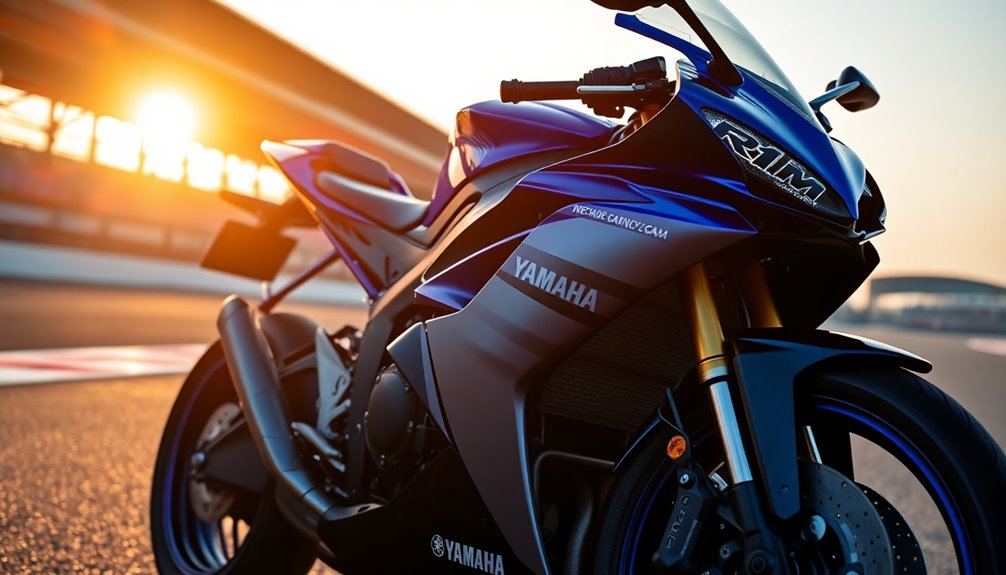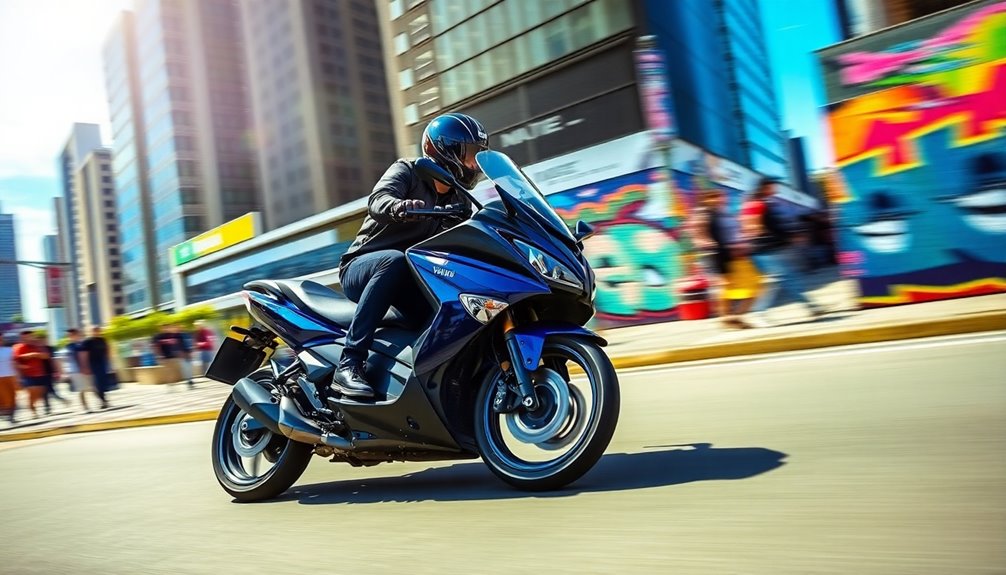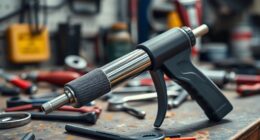The Yamaha R3 impresses with a top speed of about 118 mph, making it light, nimble, and surprisingly fast. Its lightweight chassis and aerodynamic design enhance agility, providing you a thrilling ride. With acceleration from 0-60 mph in just 5.10 seconds, you'll feel the power of its 37 hp engine right away. While the riding position is sporty, it might lead to some discomfort on longer trips, so plan for breaks. Affordable and appealing, the R3 is perfect for both novice riders and seasoned enthusiasts. There's plenty more to discover about its features and performance that could enhance your riding experience.
Key Takeaways
- The Yamaha R3 achieves a maximum speed of approximately 118 mph under optimal conditions, with real-world speeds typically around 110 mph.
- Its impressive acceleration from 0-60 mph in just 5.10 seconds showcases its strong performance capabilities.
- The lightweight chassis and aerodynamic design contribute to its nimble handling and agility on various terrains.
- The R3's quarter-mile time of 14.07 seconds indicates solid racing potential, appealing to speed enthusiasts.
- Regular maintenance and performance upgrades can further enhance the R3's top speed and overall riding experience.
Lightweight Chassis Design
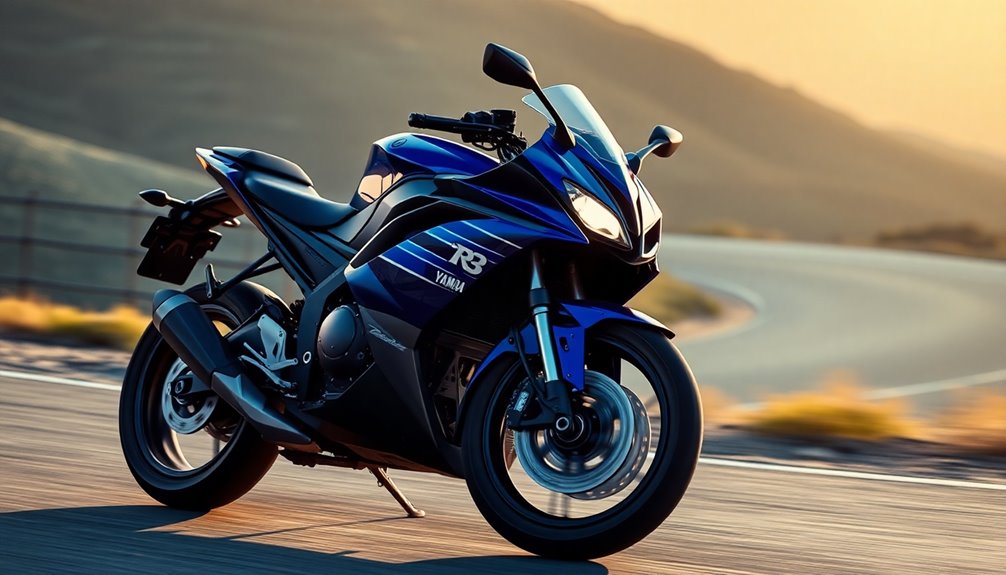
While you might expect heavy components in a sportbike, the Yamaha R3 surprises with its lightweight chassis design. Its steel diamond-type tubular frame, developed using the latest structural analysis technology, incorporates the engine's crankcase as a stressed structural member. This innovative design not only reduces weight but also enhances overall rigidity.
The main tubes are crafted from 35mm diameter steel pipe, contributing to the bike's strength without sacrificing agility. With a wet weight of only 167-170 kg, the R3 achieves an impressive 50/50 front-rear weight distribution, ensuring balanced handling. This balance is further enhanced by the Monocross rear suspension system and a long asymmetrical swingarm design, which centralizes weight and effectively transmits engine power to the rear wheel.
The frame features three rigid mounts and one rubber mount, adding to the predictability of handling. Combined with a compact wheelbase of 1380mm and a caster angle of 25.5 degrees, the R3 offers a nimble ride. Its accessible design, including a seat height of 780mm, makes it perfect for both new riders and seasoned enthusiasts looking for a lightweight, responsive sportbike. Additionally, the R3 is powered by a 321cc two-cylinder engine, ensuring that its performance matches its agile handling.
Exploring Speed and Handling
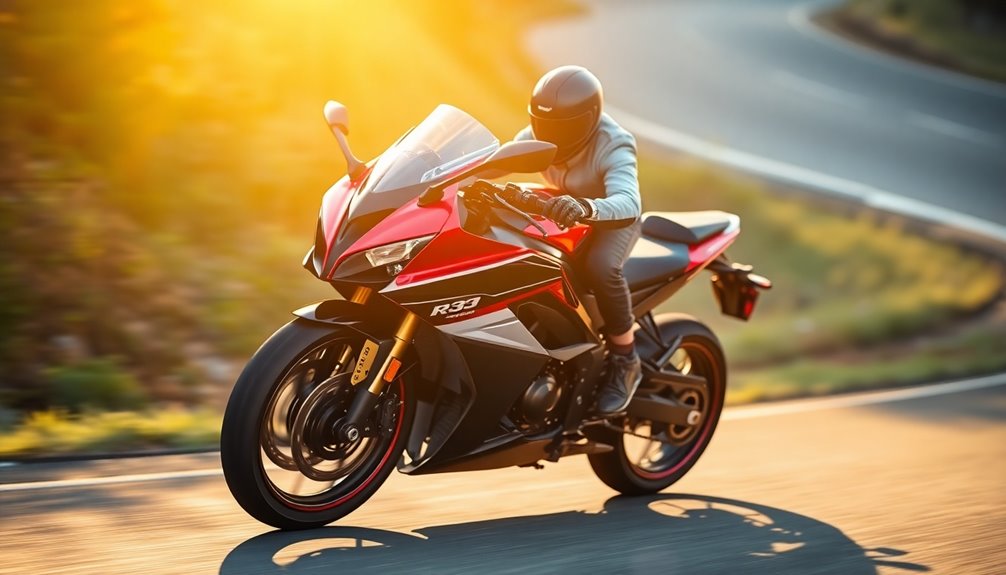
When you push the Yamaha R3 to its limits, you'll experience a maximum speed of around 118 mph, thanks in part to its aerodynamic fairing design. You'll also appreciate how quickly it accelerates, reaching 60 mph in just over five seconds. This combination of speed and handling makes the R3 a standout choice for both city riding and spirited track sessions. With a power output of 37 hp, the R3 provides an exhilarating ride that enhances its performance on the road.
Maximum Speed of 118 Mph
The Yamaha YZF-R3 impresses with a maximum speed that can reach up to 118 mph under optimal conditions, showcasing its impressive blend of speed and handling. In real-world scenarios, you might find it topping out just under 112 mph, typically around 110 mph on a highway. Factors like road conditions, wind, and your riding skills will influence how close you get to that top speed.
The 321cc liquid-cooled, inline 2-cylinder engine is a key contributor, delivering power smoothly across a broad rpm range. Its six-speed transmission ensures you can find the right gear for various situations, enhancing your riding experience. The bike's design minimizes vibrations, allowing for a more stable ride at high speeds. Additionally, the R3's fuel efficiency is impressive, with reported averages between 52 and 55 MPG, making it not only fast but also economical for daily riding.
While the R3 outperforms competitors like the Honda CB300R and BMW G 310 GS, it faces competition from the Kawasaki Ninja 400, which has a higher top speed and faster acceleration.
However, the R3's handling and ergonomics, inspired by MotoGP designs, make it a joy to ride, particularly in twisty conditions where its balanced chassis and advanced suspension shine.
To 60 Mph Time
Achieving a 0-60 mph time of just 5.10 seconds, the Yamaha R3 offers impressive acceleration that complements its top speed capabilities. While it trails behind the Kawasaki Ninja 400, which clocks in at 4.07 seconds, the R3's performance is still commendable for everyday riding. You'll find the best acceleration occurs around 7000 rpm, so hitting that sweet spot is essential for optimal performance. To maximize your acceleration, precise gear changes are crucial, especially as you aim for that 60 mph mark.
The R3's 321cc engine, delivering 37 hp at the rear wheel and 20 lb-ft of torque, provides a flexible power band that enhances your riding experience, particularly in second and third gears. However, keep in mind that real-world variability—such as rider weight, wind conditions, and road surfaces—can influence your times. Notably, the R3 can reach a top speed of approximately 112 mph under ideal conditions.
Though the R3 isn't the fastest in its class, it holds its own in real-world scenarios. With the right riding technique, including effective clutch control and timely gear shifts between 10,500 and 12,000 rpm, you can enjoy an exhilarating ride that exceeds typical car acceleration.
Aerodynamic Fairing Design
Yamaha's aerodynamic fairing design plays a crucial role in enhancing both speed and handling on the R3. The sleek fairings significantly reduce wind resistance, allowing you to cut through the air with minimal drag. This design not only boosts overall efficiency and speed but also improves high-speed stability, ensuring a smoother ride at higher velocities. Additionally, the use of chia seeds in vegan diets can help improve endurance, which is beneficial for long rides. Furthermore, a well-maintained bike can lead to better air quality in your riding environment, contributing to overall health. The integration of structured data in digital content can similarly enhance visibility and user engagement in various contexts. As with tuning options for vehicles like the Honda Accord, enhancing performance components can lead to significant gains in speed and handling.
Inspired by the MotoGP® YZR-M1, the R3's bodywork features modern styling with compact LED headlights and a central air duct that optimizes airflow. The low-profile fuel tank and compact handlebar position enhance ergonomics, making your riding experience more comfortable and controlled. Additionally, the bike's 321cc twin-cylinder engine ensures robust power delivery, further augmenting your performance on the road.
With an aerodynamic layout, you'll enjoy improved handling and control. The balanced chassis rigidity and nearly 50/50 weight distribution contribute to your confidence on the road.
The inverted fork and Monocross rear shock work together for exceptional handling, while the centralized mass ensures ultra-responsive performance. Plus, the adjustable rear shock preload allows you to fine-tune the bike for various riding conditions, giving you the versatility to tackle any situation.
Rider Comfort on Long Trips

Rider comfort on long trips with the Yamaha R3 can be a mixed experience. The bike features a relatively low seat height of 30.7 inches, making it accessible for most riders. However, the forward-leaning posture typical of sports bikes means you might encounter some discomfort over extended rides. You may feel aching in your lower back, and your knees and groin could also start to complain, especially without regular breaks. Common issues like sore wrists and a fatigued backside can arise if you push on too long. To mitigate these discomforts, consider taking breaks every 50 miles to stretch and reset. The 2019 updates improved the suspension with a new KYB fork and a stiffened rear, which can help reduce some discomfort. You might also invest in an aftermarket seat for better long-distance comfort. Additionally, adjusting the rear shock's preload can help manage extra weight if you're carrying luggage. While the R3 can cruise comfortably at highway speeds, wearing helmets can significantly enhance your comfort on longer journeys. Incorporating regular physical activity into your routine can also improve endurance and overall comfort during extended rides.
Owner Insights: Real Experiences
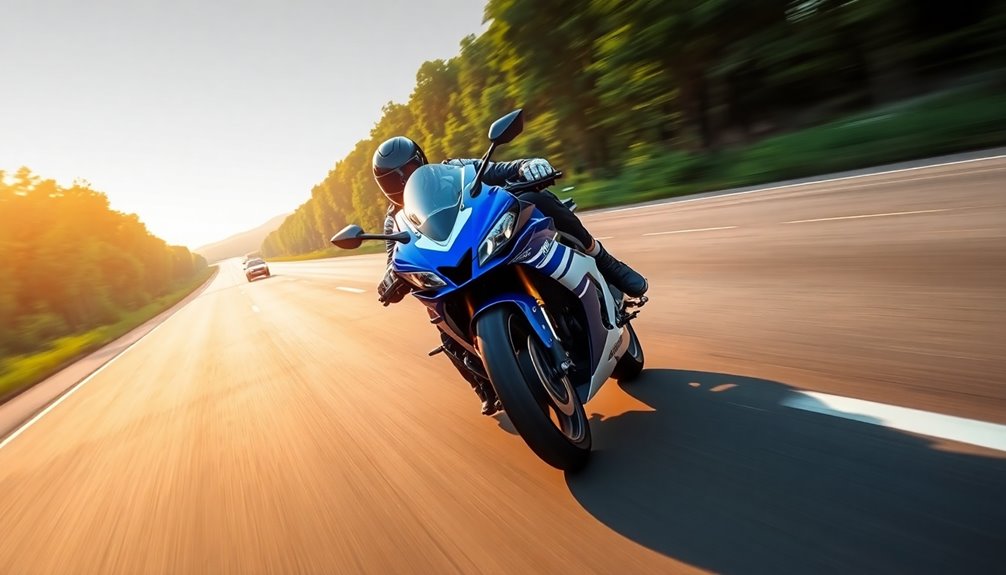
Many R3 owners rave about their real-world experiences, highlighting how the bike balances performance and comfort. With a top speed of 112 mph—and potentially 120 mph with the right conditions—you'll find the R3 delivers exhilarating speed while maintaining highway safety. Accelerating from 0-60 mph in just 5.1 seconds makes it feel quick off the line, perfect for city riding. Additionally, the R3's engine specs provide a robust 42 horsepower that contributes to its thrilling acceleration.
Owners love the nimble handling, allowing you to tackle corners with ease. The R3 turns on a dime, making it significantly easier to ride than larger bikes. However, some riders note that it can feel a bit squirmy in strong winds, which requires a bit of adjustment.
The braking system is decent but lacks the stopping power you'd want for aggressive riding, especially on non-ABS models.
Customization is common among R3 owners, with many opting for GYTR parts and custom exhausts to enhance performance and aesthetics.
Market Position and Rivals

In the competitive landscape of entry-level supersport motorcycles, the Yamaha R3 stands out for its blend of performance, style, and affordability. Targeted at novice riders and those seeking high value on a budget, the R3 excels in lively handling and lightweight design rather than ultimate performance. It's perfect for daily commuting, canyon carving, and even track days. Additionally, the cruise industry is witnessing a trend towards increased demand for sustainable travel options, which could influence consumer preferences in the motorcycle market. This shift towards sustainability aligns with the growing importance of emotional alignment in consumer choices, as riders seek vehicles that reflect their values. Furthermore, the R3's high refresh rates contribute to a thrilling riding experience, especially during dynamic maneuvers. Continuous learning about rider safety and motorcycle maintenance is crucial for all new riders.
When you consider its rivals, the Kawasaki Ninja 400 offers more power and torque but comes at a higher price tag. The KTM RC 390, with its single-cylinder engine, provides more power and tech features, making it significantly cheaper than the R3. Additionally, the R3's cost-effective ownership structure makes it a compelling choice for budget-conscious riders.
The Aprilia RS 457 is aggressively priced and competes closely, while the TVS Apache RR310, though less powerful, remains a contender in the sub-500 cc segment.
Priced at ₹4.65 lakh (ex-showroom, Delhi) or $5,299 in the U.S., the R3 finds itself in a competitive spot.
While the Ninja 400 is the priciest in its class at ₹5.24 lakh, the RC 390 and RS 457 provide appealing alternatives for those seeking value without compromising too much on performance.
Performance Enhancements and Tuning

For those looking to unlock the Yamaha R3's full potential, performance enhancements and tuning offer a straightforward path to increased power and responsiveness.
One of the most effective ways to achieve this is through ECU flashing and reprogramming. By removing stock ECU restrictions, you can optimize performance with customized ignition mapping for premium pump gas, eliminate speed and gear-based limits, and even raise the rev limiter beyond 12,500 RPM. Additionally, understanding the importance of diversification in investments can help frame your approach to performance upgrades. Modifications like ECU remapping can optimize engine performance, similar to what is done in Toyota models. Implementing advanced tuning software can further enhance the precision of these performance modifications. Regularly evaluating your modifications is essential for measuring software quality to ensure consistent performance improvements.
Aftermarket exhaust and intake systems can also significantly boost performance. Upgrading your exhaust can yield nearly 20 HP gains at the top end, especially when combined with velocity stacks. The final run metrics showcased an increase in peak horsepower and a smoother overall performance curve.
These modifications, alongside air filter changes, enhance both torque and horsepower, improving your bike's overall power band.
Additionally, utilizing fuel and ignition controllers like the Power Commander 6 allows you to fine-tune your bike's performance. You can control fuel tables, ignition timing, and even perform auto-tuning to ensure each gear operates optimally. Custom tuning options are essential for maximizing power and efficiency across various vehicles, including motorcycles.
Cost Comparison With Rivals

When comparing the Yamaha R3's pricing with its rivals, you'll notice it's positioned as one of the more expensive options in the segment. Priced at Rs 4.64 lakh ex-showroom, it stands out against the KTM RC 390, which you can get for about Rs 3.16 lakh to Rs 3.18 lakh. The Aprilia RS 457 is also more affordable at Rs 4.10 lakh.
If you're considering the Kawasaki lineup, the Ninja 300 is priced at Rs 3.43 lakh, while the Ninja 400 comes in at Rs 5.24 lakh, making it the most expensive in the segment.
Despite its higher price, the Yamaha R3 offers a solid combination of features, including a 321cc engine and dual-channel ABS. Additionally, the Yamaha R3's top speed of 188 km/h (117 mph) is impressive for its class, enhancing its appeal among sportbike enthusiasts.
However, the KTM RC 390 brings features like cornering ABS and traction control, which can be appealing if you're looking for advanced tech at a lower price point.
Ultimately, your choice will depend on what you value more: the Yamaha's brand reputation and build quality or the price-to-performance ratio of its rivals.
Young, Aspiring Sportbike Enthusiasts
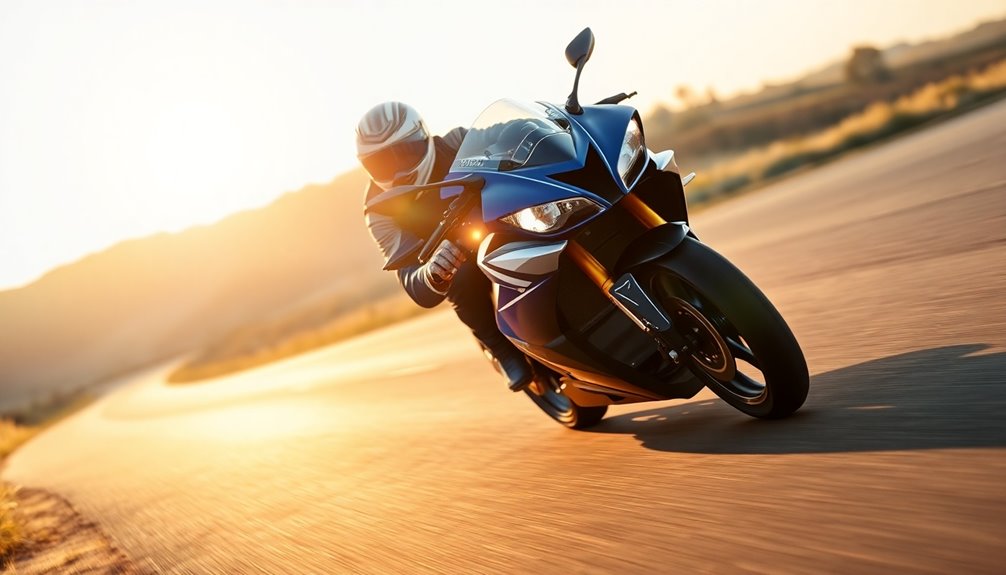
Yamaha R3's appeal goes beyond its price tag, resonating strongly with young, aspiring sportbike enthusiasts. With a 321cc engine delivering 42 hp and a top speed of 112 mph, it offers exhilarating performance without overwhelming new riders.
You'll appreciate the smooth power delivery that kicks in from 4500 rpm, peaking at 7000 rpm, making acceleration from 0 to 60 mph in just 5.10 seconds a thrilling experience. Additionally, the R3 boasts an average fuel consumption of 74 mpg, making it an economical choice for daily use. Bitcoin mining's reliance on energy consumption can be paralleled to how efficiently the R3 utilizes fuel for performance.
The lightweight frame and forgiving handling make it easy to navigate through city streets or tight corners on the track. At high speeds, the R3 maintains stability, allowing you to focus on the ride rather than wrestling with wind resistance.
Its quarter-mile time of 14.07 seconds showcases its racing potential, which is further highlighted by its success in the WSSP300 Championship.
For those eager to enhance performance, the availability of GYTR parts means you can upgrade your ride, making the R3 a versatile choice for both daily commuting and weekend track days.
With its blend of style, performance, and usability, the Yamaha R3 is an ideal gateway for young riders into the world of sportbikes.
Frequent Tire Wear Concerns
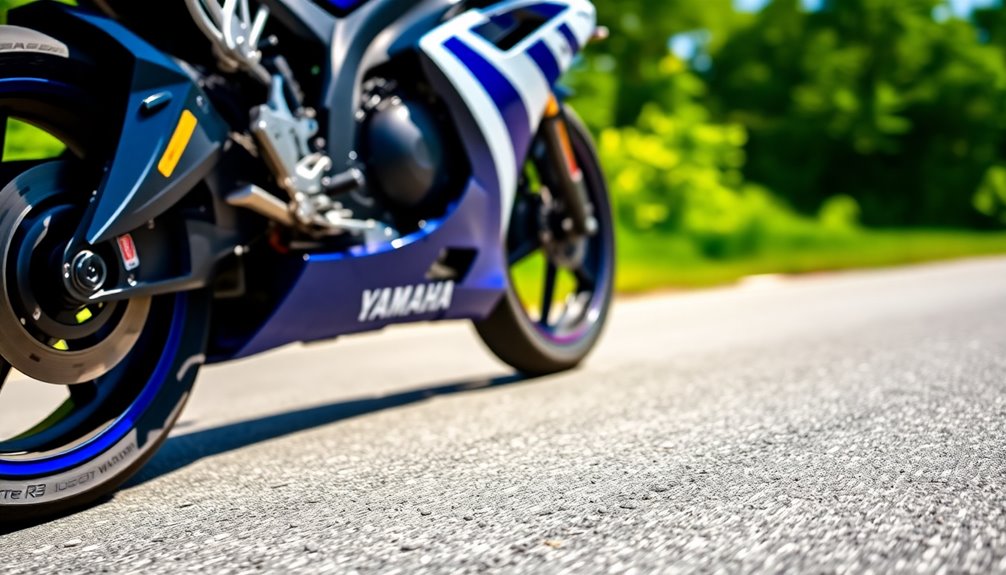
Frequent tire wear concerns can significantly impact your riding experience and safety. If you notice uneven wear patterns, it might be due to your bike's suspension settings or incorrect tire pressure. Always ensure you're using the recommended tire pressures of 2.00 bar for the front and 2.50 bar for the rear. Misalignment can also lead to premature wear, so regular checks are essential.
Your riding style plays a crucial role in tire longevity. Aggressive cornering and trail braking can accelerate front tire wear, while frequent quick flick drills take a toll as well. Adopting consistent and smooth riding techniques can help extend your tires' lifespan. In particular, overuse of trail braking can lead to faster tire degradation if not monitored.
Another factor to consider is suspension setup. Adjusting the preload or rebound damping can significantly affect how your tires wear. If you're making upgrades, such as new front springs, be mindful of their impact on tire performance.
Lastly, regular inspections and maintenance are key. Monitor your tires for signs of wear, and don't forget that proper wheel alignment and chain adjustments contribute to even wear.
Following these guidelines won't only enhance your riding experience but also keep you safe on the road.
Enhanced Braking Systems
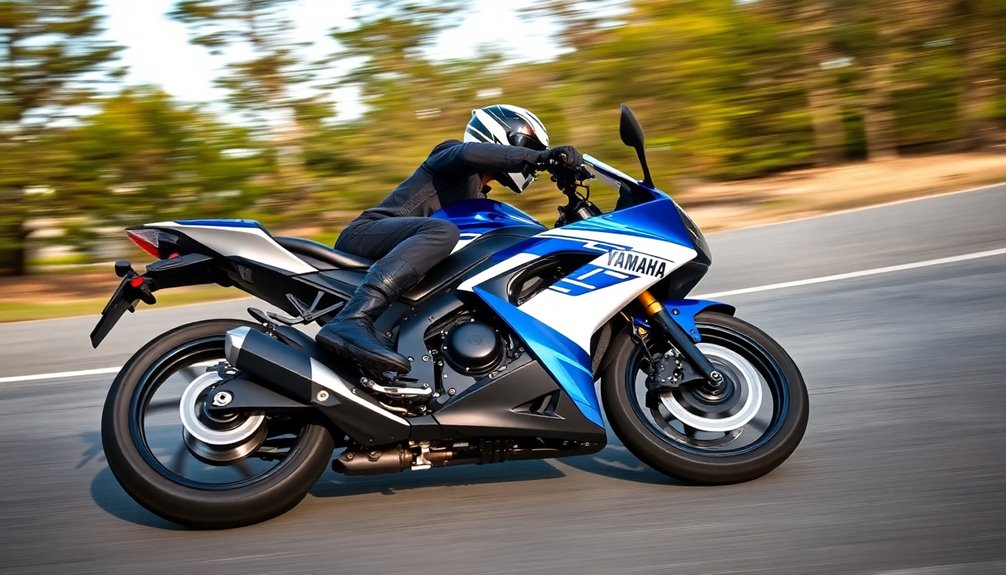
Upgrading your bike's braking system can dramatically enhance your riding experience and safety. By replacing stock rubber brake lines with braided ones, like HEL braided brake lines, you'll notice improved responsiveness and consistency due to reduced flex. Additionally, using translucent red brake lines can not only improve performance but also enhance the aesthetic appeal of your Yamaha R3.
Installing a Brembo P4 caliper will further boost your stopping power and modulation, thanks to its superior clamping force and rigid monoblock design. Just remember, you'll need a special mounting bracket for installation.
To fully optimize your braking setup, consider upgrading your master cylinder to the Brembo RCS15. It allows you to adjust the lever ratio, tailoring the braking feel to your preferences, whether for daily rides or track sessions. This precision control can transform your riding experience.
If your Yamaha R3 comes with ABS, this system enhances safety by preventing wheel lock-ups, especially in tricky conditions. While experienced riders might prefer to disable ABS for more direct control, it's generally best to leave it active unless you're confident in manual modulation.
Finally, don't underestimate how your front tire's grip impacts braking performance. Upgrading to a larger tire can significantly reduce stopping distances, making your R3 even more responsive.
Impressive Fuel Efficiency Ratings
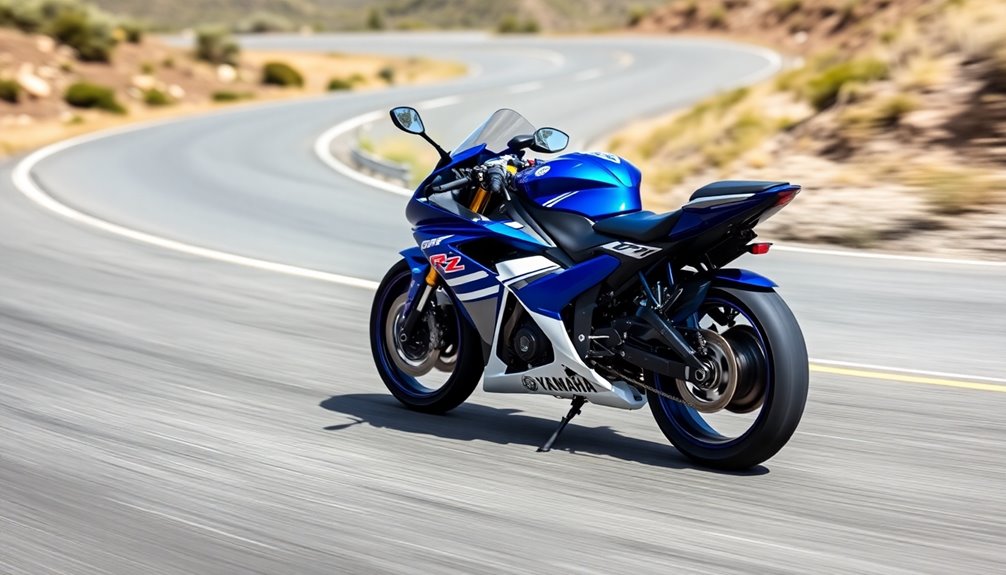
When it comes to maximizing your riding experience, impressive fuel efficiency ratings play a significant role. The Yamaha R3 shines in this department, achieving an outstanding 36.94 kmpl on the highway at a cruising speed of 80 kph. This figure comes from a thorough 60km test ride in sixth gear, showcasing how well the bike's linear power delivery and tractable engine work together to maintain efficiency, even at lower speeds.
In city traffic, you can expect around 25.71 kmpl, despite the challenges posed by frequent stops. Gentle riding can help you achieve respectable numbers, especially as the bike's design allows it to hold low speeds in higher gears. Additionally, the bike's engine type, a 321cc parallel twin, is optimized for low-speed performance, contributing to its impressive urban fuel economy.
Real-world data backs this up, with averages around 56-63 MPG depending on the model year. For instance, 2023 models average 63.1 MPG, with user reports indicating that smooth riding can push that figure to 66 MPG or more.
The R3's 321cc liquid-cooled engine, featuring advanced design elements like a 180-degree crank and DiASil construction, enhances both power efficiency and reliability.
With these fuel efficiency ratings, you'll enjoy longer rides and fewer stops at the pump.
Frequently Asked Questions
What Is the Yamaha R3's Engine Displacement?
The Yamaha R3 features an engine displacement of 321 cc. This compact size contributes to its agility and performance, making it a popular choice for both new and experienced riders.
You'll appreciate the balance between power and weight, allowing for impressive acceleration. With its 4-stroke, parallel twin-cylinder engine, you'll find it delivers a thrilling riding experience, especially when you're navigating through tight corners or cruising on open roads.
How Does the R3 Compare to the R125?
When you compare the R3 to the R125, you'll notice the R3 packs significantly more power, producing 37 hp versus the R125's lower output.
The R3 accelerates faster, hitting 0-60 mph in just 5.10 seconds, while the R125 lags behind.
Additionally, the R3's design offers better aerodynamics and a more comfortable riding position.
If you're considering performance and speed, the R3 clearly stands out as the superior choice for your riding experience.
What Safety Features Does the Yamaha R3 Include?
The Yamaha R3 includes several safety features to enhance your riding experience.
You'll appreciate the dual-channel ABS, which provides controlled stopping with its 298mm front and 220mm rear hydraulic disc brakes.
For added visibility, the bike has side reflectors and a hazard warning indicator.
The digital instrument cluster keeps you informed with an engine check warning, ensuring you stay aware of your bike's condition as you ride.
Is the Yamaha R3 Suitable for Beginners?
Yes, the Yamaha R3 is definitely suitable for beginners.
Its lightweight design and nimble handling make it easy for you to maneuver, even on tight turns. The forgiving seat height allows you to plant both feet comfortably, boosting your confidence.
Plus, features like ABS brakes provide added safety. With a user-friendly clutch and smooth shifting, you'll find riding it enjoyable and manageable as you build your skills.
What Colors Are Available for the Yamaha R3?
For the Yamaha R3, you've got some exciting color options to choose from.
In 2023, you can pick from Phantom Purple, Team Yamaha Blue, and Midnight Black, all priced the same at $5,499 in the US.
Looking ahead to 2025, you'll see Team Yamaha Blue, Matte Stealth Black, and Lunar White/Nebula Blue in the US, while Europe offers Icon Blue and Midnight Black.
Check local availability for the best options!
